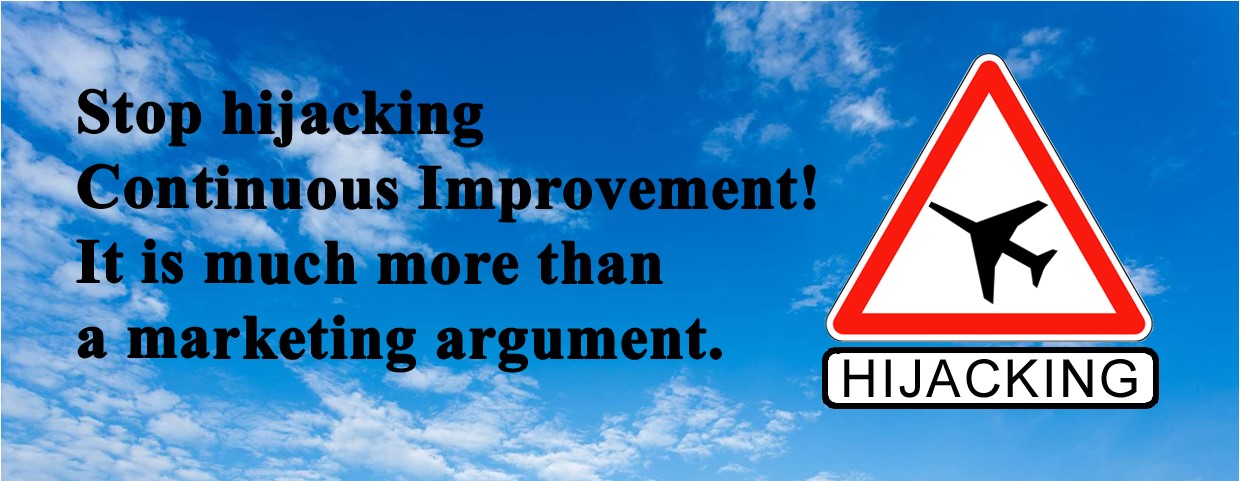
Succeed together and build a long-term partnership
Nobody anymore needs to be convinced of the importance of continuous improvement. Past decades have demonstrated how much value it has created for so many companies whatever business sector or size. However, when it comes to the relationship between a company and its service providers, continuous improvement makes the headline only at the beginning and the end of a contract period. What about all the time in between? It is quite a hot topic because there is no way around outsourcing for a company willing to focus on its core business.
Everyone for himself.
Companies and their service providers all miss the opportunity of improving together.
When transparency is increasingly required, most of the important aspects of the trade relationship between a company and its service providers remain opaque. Each party plays its part and none dares to show what it is made of. Let’s say that it requires a lot of confidence: both self-confidence and confidence in your business partner. That is where the magic words of trust and long-term partnership arise. You will barely get such a level of collaboration within a 3 year contract. Excellence requires time when results should come as quick as possible.
Which companies are ready to take the risk of engaging the partnership together and 100%?
Meanwhile, each party walks on a tight rope, each on its own. On one side, service providers’ sales strategy is a combination of “hunting” and “farming”. Keeping existing clients brings more benefits than getting new ones. Unfortunately, hunting too often consists in foreseeing – as well as overstating – improvement capabilities. Farming is nothing but rushing at making new unlikely promises during the last months of the contract, hoping that will be enough to retain the client. On the other side, as a common practice, companies initiate tenders – sometimes very early toward the end of the ongoing contract – in order to put pressure on the service provider. Companies get requested changes or not, whatever is reasonable – as defining a contractual yearly savings % – even if it means changing service provider.
Continuous improvement program is a must.
Despite the behavior of each party to the other, each one does not hesitate to invest money and keep substantial budget for setting up and maintaining a corporate strategy for continuous improvement. What company has not tried to go for Kaizen, Lean or Six Sigma…? It may look surprising and contradictory. At least that demonstrates the validity of having a continuous improvement program. It is good to take the initiative, it is better to realize it and to get paid back. Because there is one normal yet painful question here, especially for those who claim to be successful: does any company have a clear idea of the return on investment of the continuous improvement program in place? There are several challenges behind.
Change the company culture: anchor the continuous improvement mindset within the operational teams instead of relying on experts.
Best achievements rely on a community of people working together.
Some companies choose to go for the “airdropped temporary expert” way. Each of us has once experienced super clever experts getting on board from nowhere but with some complicated words and some half secret tools to make big statistics and crystal-clear reports. When their mission is over – because the time is gone or another project is starting elsewhere, there is almost nothing left. I don’t mean expert support is useless. It is certainly very good and essential to have but it is far from enough. Another way is to focus on resources and techniques. It means training from green to black belts popping up all around and corporate methodology for project management. After the initial and general enthusiasm, motivation usually gets down and performance is back to the initial level.
What is needed most is the democratization of the continuous improvement.
Less theory and more facts. Nobody else but the doers, those people who are doing the job, have the potential of mastering it. They are the ones who must be able to generate and carry out the change. So continuous improvement must be very easy to get and use. It must be exactly in line with the operations and require daily and unceasing involvement. Only this way your team will finally claim ownership of the all continuous improvement process.
The doers are a part of an organization. A full transmission belt is to be defined and combine the local drive together with the corporate guidance. That is done with a project team under the control of a steering committee. Each one, at and from his / her own level and perspective, according to his / her role, must have an easy access to the project data for each project phase – study and validation, realization and go-live, follow-up and experience sharing. Continuous improvement standard project should involve up to 6 persons and take maximum 8 weeks.
Each project should ensure the development of all involved persons’ skills.
How to choose and prioritize the continuous improvement projects?
First, let’s be clear, there is no chance to get a successful program without a clear vision of your business data.
It must be systematic. Today, any business decision is data-driven. No way to convince the financial controller, your boss, your client or your service provider without solid figures. There are a lot of innovative solutions. Robots and cobots are going to spread all over. If you intend to automate a production line, how to get a budget validation without a meaningful Return On Investment calculation? It is also true for the persons directly involved in their own projects. They strive for the most impacting projects – hopefully they are mainly rewarded based on nothing but the projects impact.
Agility all along the process.
For any idea of improvement, you must be able to measure quickly whether it makes sense or not. Any solution should be analyzed and discussed based on its potential impact considering human effort, costs and savings. Doing so, you can compare the different solutions you consider. Any implementation should be tracked and followed up versus the plan. Finally, the project, once implemented and running, should be appreciated against the expected effect. Then the full process starts again and again.
Data also mean reporting. It is the best way to keep the management informed and committed. All management levels support brings a great deal of credibility to the transformation process.
When prioritizing your list of projects, keep in mind that continuous improvement is driven by operational performance.
The respective impact of a project on operational performance is the main driver for selection. Projects with potentially quick and visible impact should also be considered. A mix of these two kinds of projects creates a positive dynamic to motivate all the team. It may also help convince the remaining unsupportive people, if any.
Succeed together and make a long-term partnership
On your way to steer your common business to excellence, define the frame and fix the rules upstream so that you won’t be afraid of being successful together.
Today, continuous improvement still drives competitive advantage. When a company and its service provider are involved, both parties should start the continuous improvement journey by collaborating very closely. Once you have developed that capacity of doing continuous improvement with your business partner, the system can be scaled up and you get a huge impact for your entire organization.
Thank you for your interest.
My next post will deal with the best way to approach the quotation process.
This post was published the 10/23/2017 on LinkedIn at www.linkedin.com/in/yannis-faure
